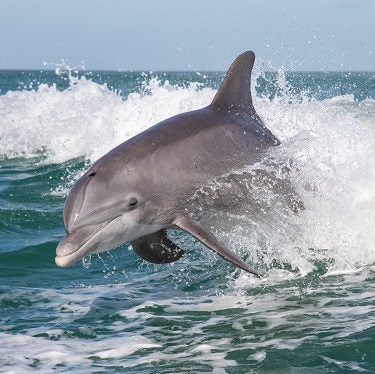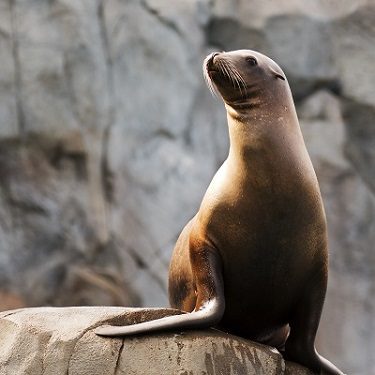Marine Life Encyclopedia
Marine Mammals
West Indian Manatee
Trichechus Manatus
Distribution
Tropical to temperate latitudes of the western Atlantic Ocean
eCOSYSTEM/HABITAT
Seagrass beds
FEEDING HABITS
Herbivore
TAXONOMY
Order Sirenia (manatees and relatives), Family Trichechidae (manatees)
The West Indian manatee, like all sea cows, is herbivorous. It primarily grazes on sea grasses and therefore spends most of its time in sea grass beds. As in most herbivores, this manatee’s brain is very small compared to its body size, likely because it does not have to develop complex hunting strategies to capture prey. It uses its thick, highly maneuverable lips to pull seagrass from the soft sediments in which it grows.
Like all mammals, West Indian manatees reproduce via internal fertilization and give birth to large young, which they nurse. A mother-calf pair will stay together for as long as two years before the calf develops some independence. Adult West Indian manatees have no natural predators, but juveniles may be eaten by large, coastal sharks.
West Indian manatees prefer warm water and undergo long, annual migrations between warm, winter areas and productive, summer areas. Wintering grounds include some warm springs, coastal seas in the tropics, and artificial warm areas caused by coastal power plants.
There are two recognized subspecies of West Indian manatees: the Florida manatee (Trichechus manatus latirostris) and the Antillean manatee (Trichechus manatus manatus). The other two distinct species of manatees are found in Brazil and in Africa.
The West Indian manatee has some or complete legal protection throughout most of its range, but it is still hunted in some places and is threatened by habitat destruction, collision with boats, and accidental capture in fisheries targeting other species throughout most of its range. Boat collisions are probably the most significant threat to this species, as they are common in recreational boat areas and are slow, poor swimmers. Populations are depleted in some places and regionally extinct in others, and scientists believe the West Indian manatee to be vulnerable to extinction. Without careful management of the human activities that threaten this species, it could be lost from more places.
Fun Facts About West Indian Manatees
1. West Indian manatees weigh up to 1,200 pounds (544 kg) and reach about 10 feet (3 m) in length.1
2. West Indian manatees eat up 15 percent of their body weight every day in sea grass and vegetation. That can be up to 150 pounds of food a day.
3. West Indian manatees migrate to warmer waters in the winter because exposure to temperatures lower than 68 degrees Fahrenheit can be deadly.
4. West Indian manatees occasionally wander into freshwater rivers and springs.
5. West Indian manatees spend 10 to 12 hours a day sleeping.
6. West Indian manatees can hold their breath for up to 20 minutes underwater, but usually surface every few minutes for air.
7. West Indian manatees swim at an average speed of 3 to 5 miles per hour (4.8-8 km per hour).2
Engage Youth with Sailors for the Sea
Oceana joined forces with Sailors for the Sea, an ocean conservation organization dedicated to educating and engaging the world’s boating community. Sailors for the Sea developed the KELP (Kids Environmental Lesson Plans) program to create the next generation of ocean stewards. Click here or below to download hands-on marine science activities for kids.
References:
1 NOAA Florida Keys National Marine Sanctuary
Get Involved

Donate Today
SUPPORT OUR WORK TO PROTECT THE OCEANS BY GIVING TODAY
With the support of more than 1 million activists like you, we have already protected nearly 4 million square miles of ocean.

TAKE ACTION NOW
Support policy change for the oceans
Decision-makers need to hear from ocean lovers like you. Make your voice heard!

VISIT OUR ADOPTION CENTER
SYMBOLICALLY ADOPT AN ANIMAL TODAY
Visit our online store to see all the ocean animals you can symbolically adopt, either for yourself or as a gift for someone else.

DOWNLOAD OCEAN ACTIVITIES
HELP KIDS DISCOVER OUR BLUE PLANET
Our free KELP (Kids Environmental Lesson Plans) empower children to learn about and protect our oceans!




